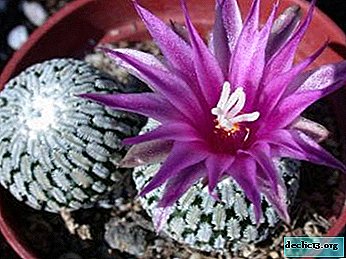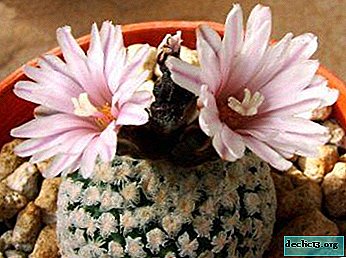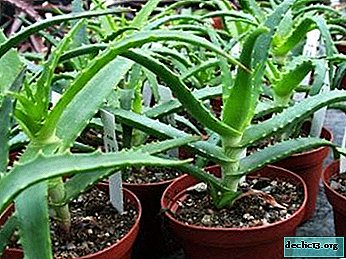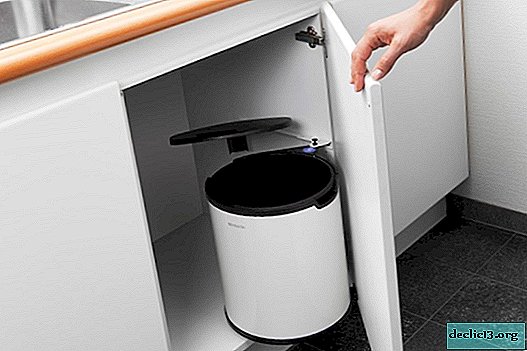Prickly houseplant - turbinicarpus. Description of the cactus, its types and varieties, care tips

Miniature turbicarcases are considered the most attractive representatives of desert cacti. Undemanding and hardy, they quickly adapt to home conditions.
This article talks about the history of this plant, what varieties it has and how to take care of it at home.
Also here you will find photos of the turbinicarpus that will help you decide whether you need to grow this interesting plant or not.
Botanical description and Latin name
Turbinicarpus (turbinicarpus) belongs to the large family of cacti. The genus belongs to the desert varieties of cacti. The literal translation of the name of the species means "pintle", "yule, turbine" and "fruit". The fruits are curved in shape, similar to pins.
Numerous varieties are distinguished by their miniature size, bright flowering and good endurance due to the powerful repetitive root.
History of occurrence and geography of habitat
At the beginning of the 20th century C. Bedeker described in detail the first representative of this genus. In the modern classification, there are up to 25 varieties of turbinicarcuses.
According to some sources, this genus includes:
- Hymnocactus.
- Pediocactus.
- Neolloyd.
Natural habitat - the northern part of the central regions of Mexico, the Chihuahua desert. They grow on stony soils at the foot of the mountains. Grow in groups.
Each species in nature grows separately, without mixing.Appearance description
They differ most often in a single stalk of spherical or slightly flattened shape. The stem is green with a grayish or blue tint. The ribs are divided into segments - tubercles. The tubercles are pronounced, rounded, arranged in a spiral.
The thorns are sinuous, long, white or yellow. Areoles are covered with white felt. The colors of the flowers are diverse - cream, pink, white, up to 4 - 5 cm in diameter. The flowers are located on the top of the stem.
Popular types and varieties of turbinicarpus
Alonsoi
The stalk is single, slightly flattened. The height of the cactus is 9 - 11 cm, diameter - 7 - 9 cm. Most of the stem is under the soil, the top is visible on the surface. The root is long, pivotal. The ribs are divided into small tubercles. The tubercles are arranged in a spiral, green or bluish in color with a grayish tint. The thorns are dense, gray in color, up to 2 cm in length. Areoles covered with reddish pubescence. The flowers are raspberry pink.

Macrochele
The stem has a rounded shape, the height of the adult flower is 10 - 12 cm. The stem is green with a gray tint. The top is covered with thick white hairs. It features long, winding spikes of light brown color. Long flowering, up to 3 - 4 months. The flowers are large. Petals are wide, spiky, white. The root is long, well developed.

Lophophoroid (Lophophoroides)
Refers to dwarf varieties. The height of the adult flower is 4 cm. The stem is single, slightly flattened, spherical in shape. Adult plants can produce stem shoots. The stem is gray - green, may be with a bluish tint. The root is compacted. The tubercles are arranged in a spiral. Areoles are initially densely pubescent, then exposed. Spines - 3 - 5 pcs.

We suggest that you learn more about the exotic Lofophore here, and you will find a description of the cactus without thorns - Williams lophophores in this material.
Clinker (Klinkerianus)
The stalk is deep green, maybe with a purple tint. The surface is matte, the stem is low, up to 4 cm in diameter. The top is densely covered with a white felt coating. The ribs are divided into wide tubercles, located spiral. Radial spines 3 pcs. The thorns are light, curved to the apex, up to 1 cm long. There are no central thorns. The flowers are white, up to 2 cm in diameter.

Polyaskii (Polaskii)
The stalk is round, flattened, up to 2 cm in height, with a diameter of no more than 3 cm. It does not give lateral shoots, the stalk is single. The surface of the stem is scored with grooves. Areoles are pubescent; they release 1 long, sinuous yellow spine, up to 1 cm in length. The flowers are white, there are varieties with pale pink flowers. Flower diameter up to 1 - 1.5 cm.

Beguini (Beguinii)
Single stalk rounded, slightly elongated. The height of an adult plant is up to 8 - 10 cm, diameter - up to 7 cm. The top of the stem is rounded, somewhat sunken, covered with white thick pubescence. The ribs are spiral. Tubercles - large quadrangles slightly compressed on the sides. The upper and lower edges of the segments are spiky. Radial spines 12 pcs. Spines light, up to 1.5 cm long, spiky, with a black tip. There are no central spines. The flowers are pink, with a diameter of up to 3 cm.

Lau (Laui)
The height of the cactus is up to 1, 5 - 2 cm, diameter - up to 2 - 3 cm. The stem is single, spherical in shape, flattened. Lateral shoots are practically not formed. The tubercles are pronounced, up to a height of 0.5 cm. Radial spines 8 pcs. The thorns are light, whitish, up to 1.5 - 2 cm in length. The flowers are white, 3-3.5 cm in diameter. Petals are decorated with a central stripe of brown hue.

Hoferi (Hoferi)
A small cactus, the height of an adult plant is up to 6 - 7 cm, diameter - up to 5 cm. The stem is single, lateral shoots are not formed. The stem is green with a grayish tint, the surface is matte. The tubercles are rounded. Spines are arranged in the form of a comb. Adult cacti have up to 7 to 10 radial spines. Spines are gray, spiky, up to 0.5 - 0.7 cm in length. The flowers are pale white, 2 - 2.5 cm in diameter.

How to care at home?
- Temperature. The optimal temperature range in the spring-summer period is 22 - 24 ° C. In autumn, the temperature should be reduced by 3-4 ° C.
Important: a hardy turbinicarpus can withstand 28 - 30 ° С, while windows should be shaded.
- Watering. Abundant watering, stagnation of water in the soil should be avoided. Spraying plants is not recommended. Watering in spring and summer requires moderate and careful. Water should not fall on the stem and flowers. It is better to water by immersion or add water to the pan. Excess water is removed immediately. Water should be soft, settled, room temperature.
Plants are watered from April to September once every 2 weeks, in summer, watering is doubled.
- Shine. Turbinicarpus prefers bright sunlight. Pots can be placed on the eastern and western parts of the house. In the summer, southern windows must be shaded so that the plant does not receive burns. Full lighting is required for the plant year-round.
Under the influence of the sun, the stem becomes dense, thorns and pubescence develop.
- Priming. The soil should be loose, drained, not nutritious. You can use ready-made mixtures for cacti. The composition of the soil mixture:
- Coarse sand - 2 hours
- Soil of spruce forests (upper layer) - 1 h.
- Drainage (fine gravel) - upper and lower.
It is recommended to add egg shells, crushed stucco to the mixture.
Replace spruce soil with a mixture of clay soil and peat crumbs, in a ratio of 1: 1.
 Pruning. Pruning is carried out in case of infection of the stem with putrefactive infections. Special shaping pruning is not needed. Cropping Pattern:
Pruning. Pruning is carried out in case of infection of the stem with putrefactive infections. Special shaping pruning is not needed. Cropping Pattern:- Damaged, rot-infected shoots are carefully cut out.
- Sanitary pruning of dry and rotted root sections is carried out.
- The rotten root is cut off completely.
- The trunk is cut from all sides.
- The trimmed plant is set in a transparent container to grow new roots.
- Roots appear within 3 to 4 weeks.
Places of slices are dried and sprinkled with crushed charcoal.
- Top dressing. Turbinicarpus does not like plentiful feeding. It is recommended to use mineral fertilizers with a low nitrogen content. You can use any additives for succulents.
Fertilize the plant should be no more than 1 - 2 times a season.
- Pot. The pot is better to use ceramic, plastic is very hot in the sun, worse passes air. The root of the plant is massive, so the capacity should be deep and spacious enough so that the roots do not bend or break when transplanted.
- Transfer. The plant is characterized by slow growth. It should be transplanted no more than 1 time in 3 to 4 years. The procedure is carried out in April. Transplantation scheme:
- The plant is carefully removed from the pot.
- A drainage layer is poured into a new container, up to 2.5 - 3 cm.
- Dry root shoots are cut off.
- Sliced areas are dusted with powdered coal.
- The flower is transferred to a new container, keeping an earthen lump.
- The sterilized substrate is added.
- Soil from above is sprinkled with gravel on the root neck.
- Watering is limited to 4 to 5 days.
- The light is diffused.
- Wintering. From late autumn to early April, watering stops. The plant enters a state of rest. The air temperature should be reduced to 10 ° C.
Important: A sharp drop in temperature to 3-4 ° C, drafts and humid air is unacceptable. Young seedlings are especially sensitive to cooling.
Features of outdoor care
Turbinicarpus - a desert cactus, in a temperate climate does not winter. In the spring, as soon as the heat is established, the plants are taken out to fresh air. Pots can be placed on a flower bed among stones. In autumn, the pots are transported to the house. In the southern latitudes cactus flower beds are planted.
The main condition is to provide good drainage and soil composition. In garden land, water stagnates. Other succulents, such as Sedums, Kalanchoe, Echeveria, are planted nearby. Watering is moderate, the lighting is bright. Above, the soil is mulched with a layer of white gravel.
Breeding
Seeds
 Seeds are pre-soaked for a day in a weak solution of manganese.
Seeds are pre-soaked for a day in a weak solution of manganese.
Seed Planting Procedure:
- A mixture of steamed soil and perlite is poured into a wide spacious tank.
- A layer of sand is poured on top.
- The substrate is moistened.
- Seeds are distributed without deepening.
- The greenhouse is covered with a film.
- Temperature - 25 ° C, light is bright.
- Seedlings dive into separate containers, after 4 weeks.
Vaccinated
Florists recommend using a more reliable method - to plant the plant on other succulents with a more powerful stem. The most commonly used cereus or perxia. The procedure is carried out in the summer.
Grown on vaccination, turbinicarcuses develop faster.Grafting procedure:
- The top of the stock is cut.
- Several shallow vertical cuts are made on the cut, up to 1 - 2 cm.
- The stem of the turbinicarpus is cut conically, inserted into the stock.
- The connection point is fixed, tied with a film, rewound with a thread.
- As soon as the stem thickens, the film is removed.
A grafted plant needs support.
Outdoor propagation
It is possible to grow turbinicarcuses in the open ground only in a warm climate. Seedlings grow up in a special greenhouse, then planted in open flower beds.
Only 2-year-old seedlings can be planted in open ground.
A prerequisite is the creation of a drainage system that passes water well. The bottom of the flower bed is covered with fine gravel.
Soil composition:
- Sand - 2 hours
- Rotting compost - 1 h.
Briefly about diseases and pests
 Due to excessive watering and abundant top dressing, the stem is deformed, cracks appear. Fungal infections provoke rot. Need pruning and transplanting. The soil and trunk are treated with Benlat powder.
Due to excessive watering and abundant top dressing, the stem is deformed, cracks appear. Fungal infections provoke rot. Need pruning and transplanting. The soil and trunk are treated with Benlat powder.- Rootworms appear from contaminated soil. When transplanting, the substrate must be calcined or steamed in a water bath.
- Preventive cultivation of the soil from garden pests should be carried out once a season with a solution of actellic or cymbush (2 ml of the drug per 1 liter of water).
Similar flowers
- Parody of Faust. Spherical miniature cactus. The ribs are spiral. Flowers in diameter up to 4 cm.
- Parody small-seeded. With age, the rounded stem elongates. The flowers are golden.
- Telocactus pusher. The stem is spherical, green. The ribs are divided into convex tubercles. Flowers of various colors, up to 5 cm in diameter.
- Telocactus haxedrophorus. The stem is roundish, flattened slightly, up to 15 cm in length. Spines are even, awl-shaped. The flowers are white.
- Echinocactus Guzoni. The plant is medium in size, up to 30 - 40 cm in diameter. The stem stretches over time. Spines are long, powerful, up to 5 cm in length.
Caring for turbinarcases is simple, the main thing is to follow the basic rules of care, conduct disease prevention, take into account the life cycle of the plant.

 Pruning. Pruning is carried out in case of infection of the stem with putrefactive infections. Special shaping pruning is not needed. Cropping Pattern:
Pruning. Pruning is carried out in case of infection of the stem with putrefactive infections. Special shaping pruning is not needed. Cropping Pattern: Due to excessive watering and abundant top dressing, the stem is deformed, cracks appear. Fungal infections provoke rot. Need pruning and transplanting. The soil and trunk are treated with Benlat powder.
Due to excessive watering and abundant top dressing, the stem is deformed, cracks appear. Fungal infections provoke rot. Need pruning and transplanting. The soil and trunk are treated with Benlat powder.















